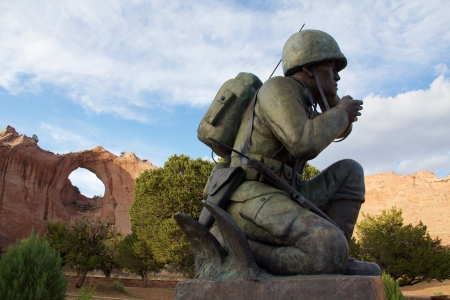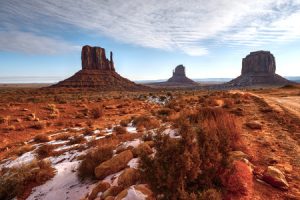
Throughout the course of the 20th century, code talkers played a huge role in the success of the U.S. military. Code talkers were military personnel who utilized obscure languages in order to communicate secret tactical messages during times of war. From the Cherokee code talkers who served alongside British soldiers during the Second Battle of the Somme in World War I to the Choctaw code talkers who helped turn the tide during the Meuse-Argonne Offensive in France, code talkers made communication more secure for the U.S. military.
The Navajo code talkers were arguably the most important and influential of them all. Although their specific role wasn’t disclosed for decades, they helped win a handful of groundbreaking battles throughout World War II.
The Original Story

The Navajo code talker statue in Window Rock Tribal Park and Veterans Memorial, Arizona.
Philip Johnston, a civil engineer in Los Angeles in the late 1930s, is considered to be the father of the Navajo code. Although he was not Navajo, he was raised on the Navajo reservation. He was the son of a missionary, and spent time learning the intricate language of the Navajo people.
In 1942, Johnston arranged a meeting with Major General Clayton B. Vogel, a high-ranking member of the U.S. military, and proposed the idea of using the Navajo language in the ongoing World War II. The various military branches had used other codes in times of war prior to turning to Navajo, but Navajo was different in that it was an unwritten language that relied heavily upon different dialects and tonal qualities. That made it impossible for anyone who didn’t speak Navajo to understand it.
Vogel asked Johnston to test Navajo code under simulated wartime conditions after hearing his proposal. Johnson demonstrated that Navajo men would be able to encode, transmit, and then decode messages in a matter of less than 30 seconds, which was lightning-fast compared to the 30 minutes it took most machines at that time to carry out the same task. Vogel accepted Johnston’s idea and told the Marines to begin recruiting 200 Navajo to serve in World War II and incorporate the code into battle.
The First Navajo Recruits
Shortly after Johnston’s proposal was accepted by Vogel, 29 Navajo recruits took part in boot camp in California in May 1942. Many of the first Navajo code talkers were Marines. While attending boot camp, they were able to fully develop Navajo code. It was a symbolic system that substituted simple Navajo words for letters.
A codebook was initially developed in order to teach Navajo code to those who came after the original 29 recruits. That codebook was used only in classrooms and was never on the battlefield.
Thus, the Navajo who practiced Navajo code had to commit everything to memory and practice encoding and decoding under the most stressful conditions.
The Effectiveness of Navajo Code

Near Monument Valley Navajo Tribal Park.
Once the Navajo code was fully developed, the U.S. military used it to transmit tactical messages while fighting World War II. From the beginning, U.S. military officials were pleased with how quickly and accurately the Navajo code talkers were able to communicate. Navajo code talkers worked with artillery units as gunfire spotters, sent out numerical messages for map locations, and ultimately served in battles in Tarawa, Guadalcanal, Saipan, Okinawa, and Iwo Jima.
The Navajo soldiers were especially effective in the Battle of Iwo Jima, which was one of the most important battles in World War II.
Six Navajo code talkers sent out and received more than 800 messages during that battle, and they did it without a single error. Later, one of the Majors involved in that part of the war said that if not for the Navajo code talkers, the Marines wouldn’t have won that battle, which could have greatly impacted the result of World War II.
In total, there were about 300 Navajo code talkers in the U.S. military by the end of World War II. They served in all six divisions of the Marines and took part in every assault carried out by the Marines in the Pacific. Without them, there’s no telling how the U.S. and its allies might have fared in the war.
The Lasting Impact of Navajo Code Talkers
Despite the great importance of the Navajo code talkers in World War II, they didn’t get any national recognition until more than two decades after the war was over. The Navajo code program was kept under wraps until it was declassified in 1968. At that point, people started to realize what a major role the Navajo code talkers played in the war. In 2001, President George W. Bush gave the Congressional Gold Medal to the 29 original Navajo code talkers.
The most amazing part of this might just be that the Navajo code is believed to be the only spoken military code that was never cracked by opposing forces during war.
To this day, U.S. opponents still haven’t deciphered it, which is why Navajo code talkers will likely go down as the most important code talkers in the history of the country.
Kachina House respects all the contributions the Navajo code talkers made during World War II and other wars during the 20th century.


Yatahey! Very detailed account of the critical role of the code talkers and all the more fascinating for that. Thank you.
Thank you for your kind words. We try very hard to be accurate and interesting in the topics we choose.